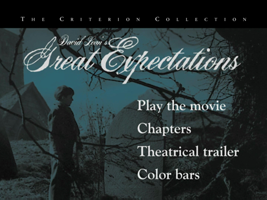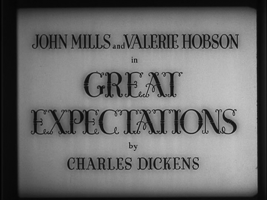directed by David Lean
written by Charles Dickens
adapted for the screen by David Lean, Ronald Neame, and Anthony Havelock-Allan, with Kay Walsh and Cecil McGivern


Criterion #31.
I sometimes have to crop out black borders on the frames that I grab; depending on the aspect ratio and the way the DVD was created, the movie image doesn’t always go all the way to the edge of the screen. Since title frames are often mostly black, which can make the edges hard to detect, I often also grab a frame from elsewhere in the movie just to determine the correct frame size, and then apply that to the title card. I say this because you’ll notice in the frame above there seems to be a black border that looks like ought to be cropped, certainly on the right and left and maybe on the top and bottom too. But when I went to compare to the rest of the DVD, to my surprise I found that apart from these opening credits, the movie completely fills the frame. You’ll also notice that the title looks kind of crooked, has terrible contrast, and is all ghosty. This is all to say that something is wrong with the titles on this disc, as though they couldn’t find a good source for them. Or else they just screwed up somehow and forgot to do their own crop.
Even the version at archive.org has cleaner titles. Of related interest: you can watch this movie at archive.org.
This is very cozy, trustworthy movie in the old tradition. I am pleased to report that I am still able to watch this sort of thing with no analytical impulses whatever. A lot of craft had to go into a movie like this and I am delighted to find myself in the luxurious position of simply being its beneficiary, rather than running some kind of surrogate production company in my head like an anxious understudy.
We, the audience, ought to be like Pip if we can, living on someone else’s dime and not having to know whether our benefactor is a crazy old lady or a filthy old man. I can say this because this disc had no commentary or extras. I say huzzah for that: it was just a movie!
Part of the reason I can retain the serenity not to “think” about a movie like this is because it’s the sort of movie that I’ve seen since I was a child and so its shortcomings are of the sort that I long ago learned to tolerate. Or rather that I learned to perceive as mysterious, part of an adult world of sense that wasn’t yet mine. Boredom in those days was neither my fault nor the movie’s; it was explained by my youth and unworldliness, so all was forgiven — of me and of the movie.
I daresay that when I was young I would have been much too bored by this movie to watch it all the way through. But that doesn’t mean I would have “disliked” it. One good image was a perfectly acceptable harvest in those days. This one has quite a few good sturdy images, starting with the graveyard scene at the very beginning. (I think I probably would have been spooked by that scene and also disappointed by the fact that the movie doesn’t make good on its implicit promise to be about spooky stuff. Books and movies were constantly pulling this sort of stunt when I was a kid. Where’s my portrait with moving eyes, dammit?)
Incidentally, I would have been bored because of what I might now say is a great strength: that it’s so true to the long-scroll/fine-brush quality of Dickens. Simultaneous commitment to the pleasures of intricate plot and to scene-painting — to the horizontal and the vertical, as they say in music — felt to me then like contradictory impulses. Delaying the answer to a mystery with a lot of stuff that has nothing to do with the mystery felt like abuse, or simply like an error, one that adult storytelling constantly made. I had no interest in pushing and popping while processing a plot. Adults are much more accustomed to stack management as a matter of course and like to feel that it enriches things. As to which attitude is correct, I’m ultimately agnostic — I’ve certainly learned very well how to savor the Dickensian method (the function of the “retarding element“), but straight-ahead no-background storytelling still feels pure to me — but I definitely prefer to be in a place where I can see both my possible attitudes equally. An old fashioned movie like this is the perfect way; images are by their nature straight-ahead even when the movie tries not to be.
This is how a Dickens movie should look and feel. The art direction was perfect. I see that I’m not the only one to feel this way about this movie. Another thing I am not the only one to feel is that the first half hour, with young Pip and Estella, is more satisfying than the rest, with grown Pip and Estella, because the adult actors aren’t as compelling. I didn’t mind so much that John Mills is clearly much much older than his character, but I did mind that Valerie Hobson is simply not a worthy successor to Jean Simmons in any department. (Valerie Hobson was, for what it’s worth, the producer’s wife, so who knows what David Lean might have thought. Probably everyone knew very well that she was the wrong choice. The movie is sort of designed not to rely very much on the adult Estella.)
Music, very comfortably done in the expected operetta/Hollywood style, is by Walter Goehr, better known as a conductor. Here’s the Main Title, your track 31 (disc 2 track 1!). This doesn’t really do the score justice; there’s quite a bit of music and some other cues are better and more original, but this is the title! It’s the big theme and that’s how it has to be. Sorry that the clarinets don’t keep it together in this take, but you know how rushed recording days can be.
More of the same to follow in #32.